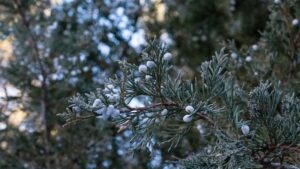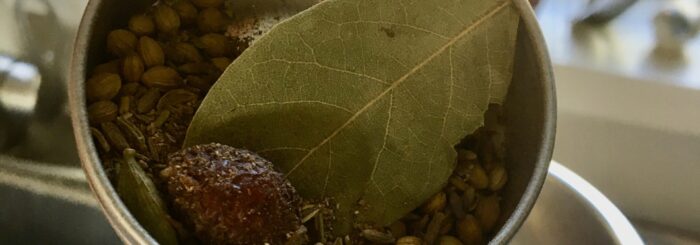And I can’t say this without thinking of “I’m Just Ken,” but be that as it may…
I recently received a “make your own” gin kit from my generous neighbors.

As someone who writes under the name of Ms. Barstool, it was an excellent choice. The kit included tools and things to add to the starter: a 750 mL bottle of unflavored vodka, which I purchased. Why start with vodka if you’re making gin? The answer, according to one of my many books on cocktails and alcohol, is that when it’s first distilled, gin is “exactly like vodka, a clear, relatively tasteless alcohol.” There are some who say that gin is just flavored vodka. Are they wrong? A discussion for another day. One thing is certain: they are both clear distilled spirits made from fermented grain (with the exception of vodka made from potatoes or beets).

Photo by Ivan Evans on Unsplash
This alcohol becomes gin when infused with a variety of botanical flavorings, with juniper berries being most prominent. In fact, if there are no juniper berries, it cannot legally be called gin. And the berries aren’t really berries– juniper is a bluish-green seed cone with lots of flesh that makes it look a lot like a berry. Historically, juniper has found several uses as a health aid. Another fun fact: the name “gin” comes from the French word for juniper–genièvre, and the Dutch genever, which the British shortened to gin. Now back to the process of making my own genièvre!

The first step was to add the juniper berries to the bottle of vodka.
The kit’s funnel was a big help in getting those little berries into the neck of the bottle. The next step happened 24 hours later.
After 24 hours, I was ready for step 2: adding the contents of the little tin filled with a botanical blend: coriander, rosemary, lavender, rose hips, allspice, fennel seed, lemon peel, green cardamom, tellicherry black pepper, and bay leaf. A note about tellicherry black pepper: Tellicherry peppercorns are larger and more pungent than regular peppercorns, with more complex flavor and added notes of citrus.This smelled quite nice as I added it to the vodka, again using the little funnel.(Other ideas for the botanicals are caraway seeds,aniseed, orange peel, cassia bark,cinnamon,ginger,and almonds–basically, anything you want.)
Years ago, I interviewed Lauren Asta who was the tasting room supervisor at St. George Spirits in Alameda. When she spoke about Terroir, one of St. George’s gins, she described it as “a hike and Christmas in a glass.” As I wrote, “Say you’ve just been on a hike in a lovely California park. You may have run across Douglas fir, California bay laurel, coastal sage, and other aromatic botanicals. A couple of tastes of Terroir, and you would swear you’re still on the trail.” Lauren was able to rattle off the 19 botanicals that go into the making of Botanivore, one of the four St. George gins: this one contains a blend of elements that may remind you of “a meadow in bloom—herbaceous, fresh, and elegant.” What should you be sensing in that first sip? How about these: Angelica root, bay laurel, bergamot peel, black peppercorn, caraway, cardamom, cilantro, cinnamon, citra hops, coriander, dill seed, fennel seed, ginger, juniper berries, lemon peel, lime peel, orris root, Seville orange peel, and star anise. As Lauren says, anything goes when it comes to gin, as long as those juniper berries are in the mix.

After another twelve hours, it was time to thoroughly strain the infused liquid into the pair of cute little bottles that came with the kit. The color was kind of golden, which the instructions say is how unfiltered gin is supposed to look.

And finally, the fruits of my labor: a delightful gin and tonic, made with my very own gin! L’chaim!

It’s 5:00 somewhere!

